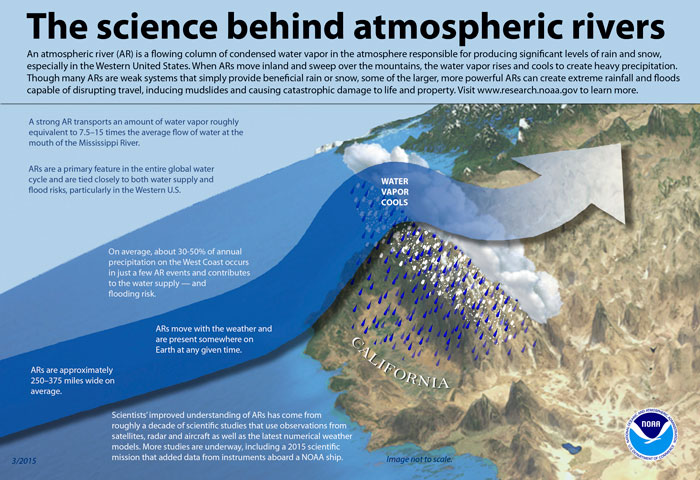They navigated the streets in kayaks instead of cars. A rising surge of water that turned their community into a swampland left them no choice.
But while some residents of Guerneville will point to a cresting tributary as the cause of the catastrophic floods that devastated their Northern California town early last year, it was a river of a different sort—one that flows high above land—that was actually to blame.
Atmospheric rivers—long, narrow corridors of water vapor in the sky—move with the weather, producing massive amounts of rain and snow when they make landfall. In late February of 2019, an especially potent atmospheric river dumped record-breaking rainfall in the region surrounding Guerneville, causing the Russian River to overflow its banks and inundate the small town.
Breanna Zavadoff, a doctoral student at the University of Miami’s Rosenstiel School of Marine and Atmospheric Science, remembers the flooding event quite well. “The soil was already moist in the region, so it couldn’t act as a sponge,” she said. “Once the river overflowed, the whole town was essentially submerged.”
Zavadoff, who studies meteorology and physical oceanography, is fascinated by all kinds of weather phenomena, especially atmospheric rivers (ARs). She uses observation-based forecast data to analyze their behavior, which can often be erratic.
“They can be double-edge swords in some respects,” she said, referring to their Dr. Jekyll and Mr. Hyde attributes.
 Sometimes called “drought busters,” ARs can produce up to 50 percent of California’s precipitation, helping to replenish reservoirs in the northern portion of the state. “But on the flip side, those that contain the largest amounts of water vapor can produce too much rain in too short a period of time, and that’s when floods can occur,” Zavadoff said.
Sometimes called “drought busters,” ARs can produce up to 50 percent of California’s precipitation, helping to replenish reservoirs in the northern portion of the state. “But on the flip side, those that contain the largest amounts of water vapor can produce too much rain in too short a period of time, and that’s when floods can occur,” Zavadoff said.
One of the best-known atmospheric rivers is the Pineapple Express, which carries moisture from Hawaii all the way to the West Coast of the United States.
It is the impact of atmospheric rivers on Europe, however, that is the specific focus of Zavadoff’s research. ARs, she said, have a considerable impact on that continent as well, causing major flooding and landslides in the Iberian Peninsula and accounting for the 10 largest winter floods in the UK since the 1970s.
“If we could better predict where they will hit and determine if they’ll help or hinder, it would be a tremendous help to emergency response managers and forecasters,” Zavadoff said.
Looking more closely at a phenomenon known as atmospheric Rossby waves could hold the key.
Named for the Swedish-born meteorologist Carl-Gustaf Rossby, who was the first to identify them and explain their movements, atmospheric Rossby waves are giant meanders in high-altitude winds that influence weather and are associated with pressure systems and the jet stream.
“They’re quite easy to observe,” said Zavadoff, “and they may actually help guide atmospheric rivers.”
Using archived data from NASA satellites and weather forecasts, she compiled a 38-year climatology record of atmospheric rivers throughout Europe, finding that many of the ARs that affected the continent during that span (73 percent) were located near anti-cyclonic Rossby wave-breaking events—an occurrence in which the meanders are stretched from north to south.
“And when atmospheric rivers are in sync with anti-cyclonic Rossby wave breaking, the rivers tend to be stronger,” Zavadoff said. “So forecasting such an event could help us model atmospheric rivers more effectively.”
Atmospheric rivers all over the world could become more intense as climate change worsens, Zavadoff warns. “Because of warming temperatures, the atmosphere will be able to hold more moisture, which will make rivers stronger and capable of dumping more rain,” she explained.
Since she was 10, Zavadoff has been intrigued by weather, often tuning in to the Weather Channel for hours to watch the station’s extensive tropical storm coverage during hurricane season.
“Weather affects everyone—every single hour of every single day. And, that’s what has always fascinated me,” she said.
It isn’t just atmospheric rivers that will become more extreme as climate worsens. Storms, drought, and fires will also increase in intensity, Zavadoff said, echoing the sentiments of researchers and scientists all over the world.
“We’ve got to get everyone on the same page,” she said. “We need to ramp up the dialogue that the science of climate change is fact and not just a belief.”

